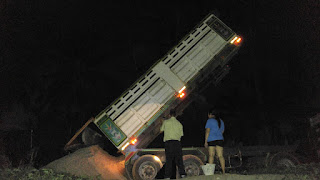The washing of the sand is proceeding at a very slow pace. We are still washing the sand manually, one load at a time in 2 cement mixers. It is a slow and laborious process that will probably go on for another month or two at this pace.
So we decided to experiment with an alternative. We had found one company that sells washed sand. The sand price itself is about the same as other sand we can source locally, but the cost of transporting it to our site from Chachoengsao province effectively doubles its price. That, and a few months ago when we explored it, the lack of rainfall meant they didn’t have enough water for the washing process. So we proceeded with manual washing ourselves in a natural water body on our land.
But this week, we checked back, and they said they had enough water to resume the process. So we decided to order a sample truckload. They said it would arrive in the afternoon, and we made plans to swing by before they unload so we can measure the actual volume. (It is sold by weight, not by volume, and weight can vary a bit depending on how wet it is when they load it.)
Unfortunately, everyone involved forgot that the larger trucks are not allowed on the streets of Bangkok until about 9pm. So the delivery time was pushed back to about 10pm. Resulting in a strange and slightly surreal run to the land before bedtime to climb the back of the truck and take measurements.
Here are some (dark) photos of them unloading:
If you look carefully at the second picture, you can see it is a double trailer truck with the back trailer dumping and the lights on the front trailer visible in front. Based on the receipt from the truck scale they used when the came into town, the load was 28.55 tonnes. We measured the inside of each trailer to be about 5.8m x 2.3m. The depth of the sand was a bit more difficult since it was mounded. But a visual approximation put it at 0.6m deep. This comes out to about 8 cubic meters per trailer, or 16 cubic meters for the 2 trailers.
Dividing 28.55 tonnes by 16 cubic meters comes out to about 1.8 tonnes per cubic meter. This puts it between the 1.6 tonnes for dry sand and the 1.9 tonnes for wet sand listed on this weight converter. This sounds about right.
The sand is actually quite nice looking. It is whiter than the usual sand we are getting, and has a bit of pink in it. It is probably meant for golfing sand pits. The sand is still about double the price as the other sand we are getting, but if we include the labor cost of washing it, it comes out to about 50% more expensive.
I still have to ponder whether the time savings is worth the price increase. Probably not. But at least we now know it is an option, should we need it.
For now, I think we will look at buying bigger cement mixers to speed up the process. When it comes down to it, I feel better paying less money to our (local) workers to wash the sand rather than paying more money to truck washed sand in from another nearby province.

